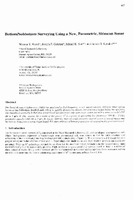| dc.contributor.author | Wood, Warren T. | |
| dc.contributor.author | Gettrust, Joseph F. | |
| dc.contributor.author | Sen, Mrinal K. | |
| dc.contributor.author | Kosalas, James G. | |
| dc.date.accessioned | 2018-10-11T14:08:33Z | |
| dc.date.available | 2018-10-11T14:08:33Z | |
| dc.date.issued | 1997 | |
| dc.identifier | 11524 | |
| dc.identifier.govdoc | CP-45 | |
| dc.identifier.uri | http://hdl.handle.net/20.500.12489/479 | |
| dc.description.abstract | The Naval Research Laboratory (NRL) has developed a dual-frequency, towed, interferometric, sidescan sonar system known as the Subbottom Swath System, which is capable of detecting objects and structures buried below the sea floor. The transducer geometry is that of a conventional interferometer side scan sonar system but with a more powerful (241 dB re I @a @ Im) source. As a result of this power, s3 is capable of generating low frequency (500 Hz - 2 kHz) parametric signals (-203 dB re I @a @ lm for 1600 Hz) that can easily penetrate several meters to tens of meters into the bottom. Datafrom a test in Puget Sound, WA show evidence of bottom penetration of parametrically generated sound. | |
| dc.format | 6 p. : ill. ; digital, PDF file | |
| dc.language | English | |
| dc.publisher | NATO. SACLANTCEN | |
| dc.source | In: High Frequency Seafloor Acoustics (SACLANTCEN Conference Proceedings CP-45), 1997, pp. 607-612 | |
| dc.subject | Side scan sonar | |
| dc.subject | Parametric sonar | |
| dc.subject | Seafloor characterization | |
| dc.subject | Buried objects detection | |
| dc.subject | Mine burial and bottom conditions | |
| dc.title | Bottom/subbottom surveying using a new, parametric, sidescan sonar | |
| dc.type | Papers and Articles | |
| dc.type | Conference Proceedings (CP) | |
